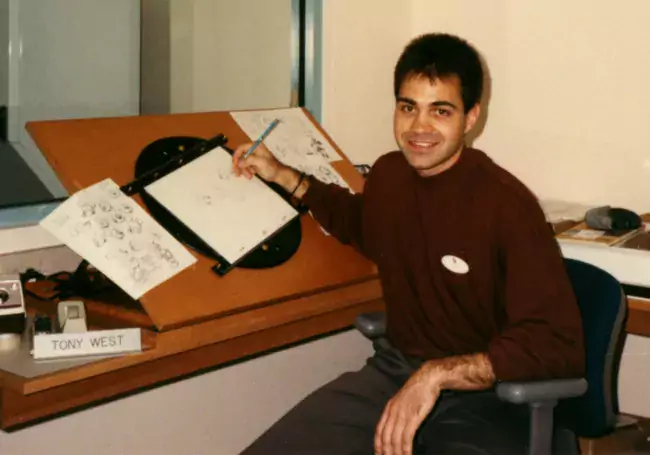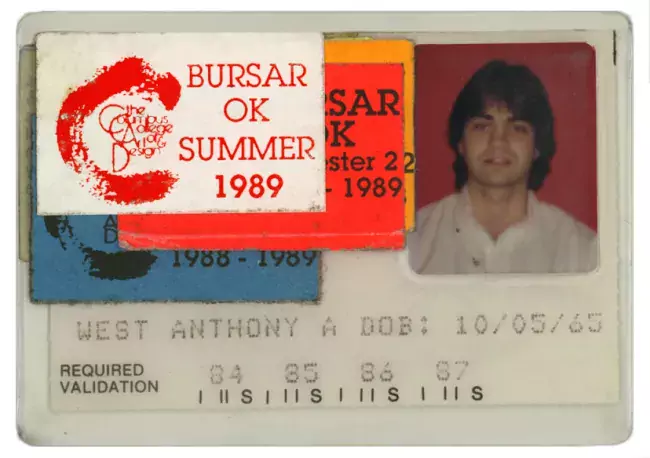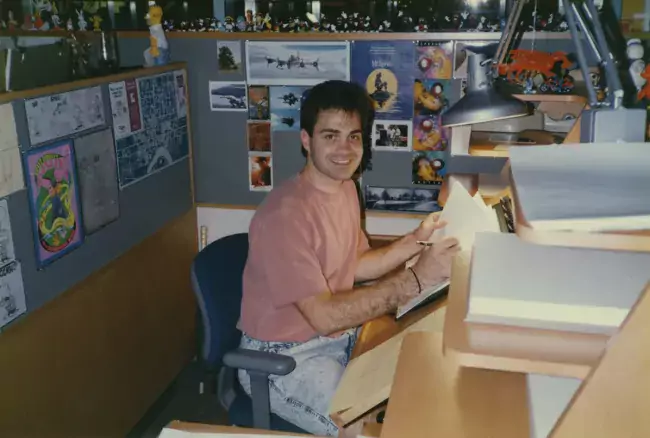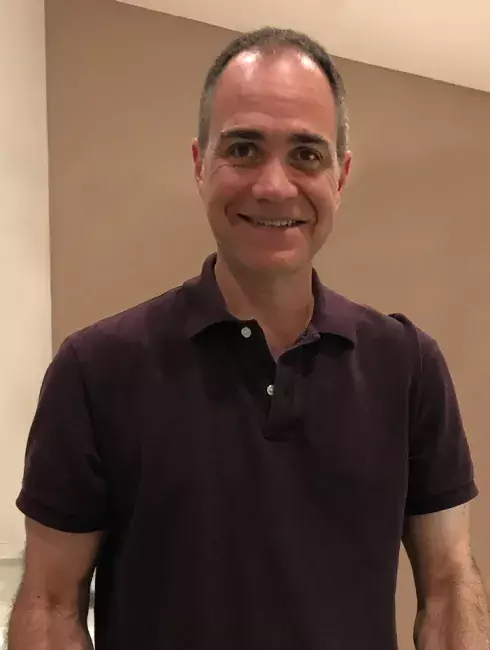
Alumni Q&A: animator and artist Tony West

Tony West at his internship at Disney MGM Studios in Orlando in 1989.
Throughout his career, Tony West (Illustration, 1989), who worked for 15 years as a visual effects animator for Walt Disney Feature Animation, has been incredibly influential in the careers of the CCAD artists and designers who came after him.
“On our recent alumni outreach trip to the Orlando area, it really seemed that almost every person we met with knew Tony,” says Stewart McKissick, CCAD chair of Illustration and Comics & Narrative Practice. “He was clearly the center of the CCAD alumni community in the region. Many said it was Tony who initially reached out and convinced them to apply to work at Disney and continued to encourage them over the years.”
During his time at the Disney MGM Studios in Orlando, a gig he got following a 15-week animation internship in 1989, West worked on many projects during the legendary second golden age of animation in the 1990s.

Tony West’s CCAD student ID.
Though his internship placed him in the character animation department, it was the visual effects work that he found really fascinating. (That, and walking through the Ink and Paint department as they were finishing up the colors for “The Little Mermaid.”)
“I liked what the visual effects team did. In character animation, you could be drawing the same thing for two years,” West recalls. “But the effects guys were a supporting role of character animators. They were drawing fire one day, smoke the next, a crumbling mountain. What they work on changes throughout the picture because there are a broad spectrum of effects. I gravitated toward that.”

“Funny story about this desk,” West says. “When the studio closed there were literally tons of animation desks and Disney let us purchase them if we wanted to. Because I'm tall, my very first desk was specially modified to fit me better and it is the desk I used throughout my career at Disney. There was no way I was gonna leave the studio without my desk so I bought it and it sits in my home studio to this day. I don't use it as often as before but I couldn't imagine not having it. I spent nearly a third of my life working at that desk, and I really love the thing.”
His first film credit was “The Rescuers Down Under,” and he also worked on such classics as “Beauty and The Beast,” “Aladdin,” and “The Lion King.” His work on “Mulan” can be seen in the battle cannons and the intricate scene of the lotus flower falling out of a tree onto Mulan’s father’s lap. West’s favorite work with Disney, though, may have been on “Lilo and Stitch,” because of the “old school” look and feel of the film, especially the watercolor backgrounds.
“I really loved ‘Lilo and Stitch’ artistically and aesthetically,” West says. “It’s such a neat looking film.”
When the company closed the Florida studio West worked at in the spring of 2004, he dove into a producer role on a catharsis-like film project with artist Dan Lund. “Dream on Silly Dreamer” was a documentary about the rise and fall of traditional animation at Disney from 1980 to 2005.
“It was my dream job,” West says. “It was the job I always wanted as a kid. If I had a million dollars I would have bet every cent I would retire there. … But this happens. It was one of those things you go through and you think what the heck and I am going to do next.”
Next for West was a freelance career that includes credits for the studio Project Firefly, helping animate “The Princess and The Frog,” and illustrating for Disney theme park merchandise. He also recently co-launched—alongside fellow CCAD alum Hugo Giraud Jr. (Illustration, 1998) —the company Pin Cats, where he gets to design and illustrate all kind of interesting characters.
But whatever West draws next, it’s his personal character that will continue to be memorable.
“His generosity of spirit, and genuine love for the world of making art and his fellow CCAD family was clear and contagious,” McKissick says. “It was inspirational to meet him and all the rest of the folks.”
What is your creativity’s origin story?
I’ve always loved a good origin story. I was a lucky kid because I was encouraged to do whatever I wanted, within reason, when it came to creative stuff. I could be as creative as I wanted to be. We would go to Pennsylvania to visit my grandparents, and they had one of those big calendars with the tear-off page for every day. I would make flipbooks in the corners of those calendars. They were crude, falling bouncing ball kind of thing. A car would crash into the side of the paper. A rocket launched. I was encouraged to continue on with those endeavors, and that’s one of the things that shaped where I was headed, on a level I didn’t even understand at that age.
What was that Disney internship like in hindsight?
That internship was one of those things where you walked in and realized you were sort of on a different level now. … After I’d gotten hired, every morning I’d wake up and think I really can’t believe I get to do this. I can’t believe they’re paying me to do this. I’d never tell them, but I would have paid them to do it. It was absolutely a life-changing event for me and it set the course of my life. I realize how unique that is. Not everybody gets a great break. I see how fortunate I was to get that at an early age.

Former CCAD classmates and Disney effects team animators, Tony West (Illustration, 1989) and Derrick McKenzie , at a studio reunion.
Why have you helped so many other people build up their own careers?
I know that I’ve helped people out, but I think I did it because I thought this is the coolest thing ever and everybody should get to do this. There were opportunities and I’d see openings, and it was just like connecting the dots. I saw that the studio had a need and this person would be great for that. It was probably selfish. I wanted to work with all my friends.
What advice would you offer a young artist?
Be open to what comes your way. That’s not to say sit back and wait for things. If you wait, nothing will probably happen. Look in places you might not have thought to look before. Opportunity is everywhere, you just have to go and find it. And that’s for any discipline. You might be in fine arts and see this opportunity to be a texture painter for films. Same discipline, different medium. There are so many opportunities it’s almost mind boggling. Unless you know exactly what you want to be from birth, you should look all over the place and don’t make your focus so narrow that you miss things.
What do you foresee for the future of animation?
I think animation is unique because it encompasses everything you go to art school for—painting, drawing, sculpting, perspective. Every discipline an art school offers, there’s some element of it in animation. You take written word and translate it into a visual medium that’s greater than all the sum of its parts. It’s just the most amazing experience and process. The fact that it’s collaborative makes it even cooler. Animation, the thing I like most about it, is our only limit to it is imagination. As long as there’s imagination in the world, animation will thrive.

Tony West in 2017.
Learn more about CCAD’s Illustration and Animation programs, and stay tuned for our next alumni events here.
Post date
April 25, 2018